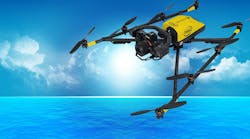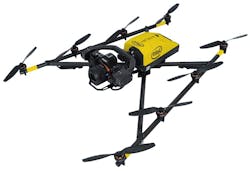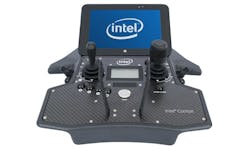Download this article as a .PDF
Intel may have shut down its Intel Developers Forum (IDF) show and pulled out of other venues it has sponsored, like the Intel International Science and Engineering Fair, but has been focusing on other arenas ranging from artificial intelligence to drones.
Intel CEO Brian Krzanich was the keynote speaker at this year’s AUVSI Xponential show in Dallas. Of course, he presented the company’s vision for drones, and one of the platforms he talked about was its Falcon 8+ (Fig. 1), one of the thousands of unmanned aircraft systems (UASs) on display at the show. Krzanich also talked about the MAVinci Sirius Pro System, another Intel acquisition, and the Intel Shooting Star drone light shows used for entertainment exhibitions. Three hundred Shooting Stars were used to create the Pepsi Zero commercial for Lady Gaga’s Super Bowl halftime show.
The Falcon 8+ octocopter has eight blades to provide a more stable platform for heavy payloads. It is designed to minimize magnetic field disturbances and has a high-precision GPS. Ascending Technologies, now part of Intel, provides the triple-redundant autopilot technology, AscTec Trinity. The system uses three redundant inertial measurement units (IMU) that help compensate for external influences like electromagnetic fields or strong winds.
A Falcon 8+ can be controlled by the matching Intel Cockpit Ground Control Station (Fig. 2). This waterproof pilot control system has a joystick that allows for single-handed flight control. It is also integrated with an Intel tablet. The system is designed to match video payloads that delivery 1080p video streams in real time.
There is a Survey Package designed for highest-resolution inspection, surveying, and mapping. It adds a Sony Alpha 7R camera with a 36 Mpixel, full-frame DSLM camera that uses a Sonnar FE 35mm f/2.8 ZA Lens with Carl Zeiss anti-reflective coating, in combination with a 35 mm full-frame sensor and BIONZ image processor. There is also a ZS 50 inspection payload with a hybrid RGB plus 14-bit RAW data inspection payload that combines a near-infrared camera with a different high-resolution camera.
The system supports the Quick Survey tool for automated survey flight configuration. It requires entry of parameters like the ground sample distance, start coordinates, and final angle via the ground control station. The drone then sets the flight altitude, speed, GPS-based photo positions, and overlapping configuration to provide the desired results within the shortest flight time. The software also supports a Circle of Interest (COI) function that creates a circular waypoint flight, enabling the systematic capture of multimedia data around a point of interest.
Intel has also developed the Intel Powerpack, a small battery that has automatic balancing, storage mode, charging, and LEDs that display remaining battery life for use with the drone and the cockpit. The drone uses a pair of Powerpacks in a redundant configuration. The V-shaped octocopter has a flight time of 16 to 26 minutes. It can handle wind speeds up to 12 m/s when using GPS and 16 m/s when using manual mode. The system uses dual, 100 mW command and control links operating as 2.4 GHz with an adaptive FHSS link.




